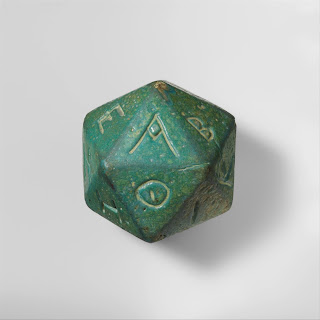A number of polyhedra made in various materials are known from the Hellenistic and Roman periods. They may have been used in conjunction with an oracle inscribed on a pillar set up in a public place. The polyhedron was thrown in order to choose a letter at random. One consulted the inscription to find the matching letter and read the oracle's response. There would be twenty oracular messages, each beginning with a letter of the alphabet that corresponded to one side of the dice. - Metropolitan Museum of Art
This polyhedron has 20 sides, each inscribed with a letter of the Greek alphabet from A (alpha) to Y (upsilon). Only the last four letters (phi, chi, psi, and omega) are missing.
A table of the 20 Oracles originally from an inscription found in Olympos, a city in ancient Lycia, is available here:
http://opsopaus.com/OM/BA/GAO.html
It includes four more Oracles for the last four letters of the Greek alphabet if you have a 24-sided die. It also explains the values obtained from the use of astragaloi (knuckle bones).
Formal oracles connected with the use of lots or dice included the oracle in the temple of Heracles at Bura. The casting of lots was also used at Delphi when the Pythia was indisposed. Although prophecy by the casting of lots was practiced in the Roman Republic and Empire, it was generally regarded with contempt and not practiced for state purposes. This may have been because gambling with dice, "aleam ludere", although widely enjoyed, was technically illegal.
The importance of prophecies increased during the Imperial period, though, and oracular responses began to take the form of prose using lines from Vergil. The public declaration of oracles ended with the condemnation of paganism during the reign of Theodosius at the end of the 4th century.
Image: Faience polyhedron inscribed with letters of the Greek alphabet, Roman, 2nd–3rd century CE at the Metropolitan Museum of Art courtesy of the museum.

No comments:
Post a Comment